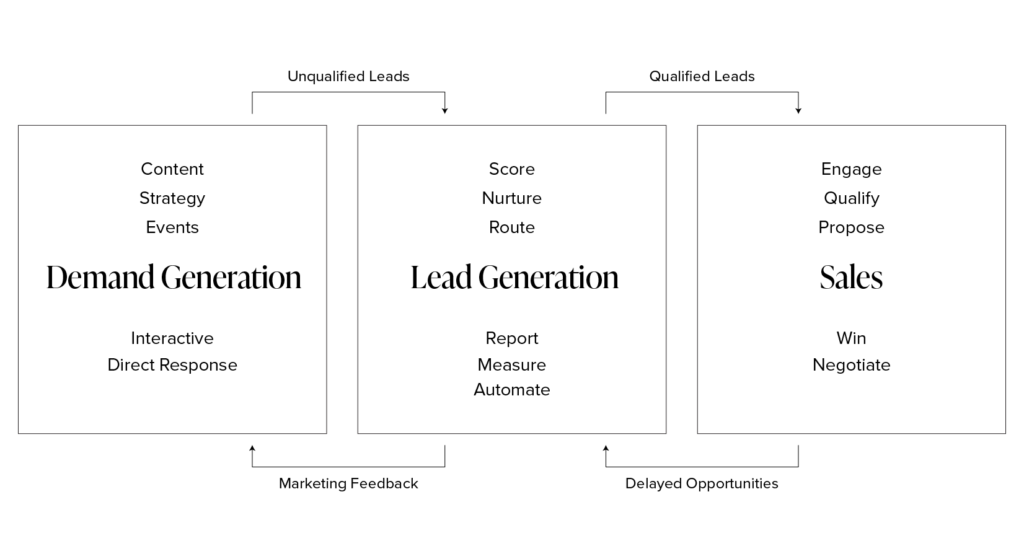Every business owner wants to drive more sales and grow their customer base (and their bottom line). A digital demand strategy can help generate more leads and conversions, and can also be used as a tool to effectively increase brand awareness. Multiple marketing methods can be used in conjunction with one another to create an effective digital demand strategy. A successful demand generation strategy provides your business with a consistent baseline of new business by creating an optimized customer journey to maximize new revenue. Once you’ve created a clear, effective pipeline from the awareness stage to the decision stage, the result is a predictable ROI.
What is a Digital Demand Strategy?
A digital demand strategy focuses on creating awareness and interest in a product or service through various digital marketing channels. It aims to generate demand for the product or service by attracting and engaging potential customers with relevant content, advertising, and other marketing tactics.
Demand Strategy vs. Lead Generation
Demand generation is not to be confused with lead generation. While both strategies are important for a company’s growth, they have different goals and approaches. A digital demand strategy is more focused on building brand awareness and generating interest, while a lead generation strategy is more focused on identifying and converting potential customers.
An Omni-Channel Approach to Creating Demand
It’s important that your demand generation strategy takes an omni-channel approach. Digital demand requires a long-term, holistic strategy and cohesive messaging across every touchpoint. There are many tactics to drive demand, including content marketing, PPC campaigns, SEO and inbound marketing, and industry-relevant PR marketing. What your demand generation strategy includes will depend on your industry, but ideally, it should include multiple tactics.
Content Marketing
Successful content marketing for demand generation depends on the distribution of relevant, valuable content at every stage of the customer journey. This can be accomplished through content such as blog posts, articles or white papers. When writing white papers and articles, ensure you are covering topics relevant to your target audience. Aim to address common pain points or answer frequently asked questions. Your goal should be to become a reliable and frequently referenced source of information. By providing valuable content to your audience, you build brand authority and credibility, which in turn generates interest in your product or service.
Social Media
Social media is one of the most widely used channels that consumers use to interact with businesses. Properly leveraging your social media will allow you to connect with potential customers as well as retain existing ones. When creating your social media strategy, you should establish several content pillars to help you create relevant, targeted content. Your primary goal on social media should be to increase brand awareness. By creating engaging content, you encourage your audience to follow your account. This is a great way to establish brand awareness as well as familiarize your followers with your products or services.
Pay-Per-Click Advertising (PPC)
Pay-per-click advertising (PPC) ads, such as Google ad campaigns, are an opportunity to meet an interested customer where they need you most. By targeting people who are actively searching for what you offer, you’re engaging with an audience that may already be in the consideration phase. Being able to strategically lead them through to the decision phase is more cost-effective when you’re aligned with your buyer’s intent.
Search Engine Optimization (SEO)
SEO is where demand generation starts at the top of the funnel. Effective SEO practices allow you to attract potential customers that are interested in your niche. However, this doesn’t guarantee that they will be interested in your product or service, which is where your demand generation strategy will come into play. Being able to understand your customer persona and identify their pain points will be key in delivering the information they need to generate further interest in your brand.
PR
PR marketing is especially important for B2B businesses, but it also plays a part for B2C demand generation. Knowing where your ideal customer spends their time and which sources they trust will allow you to target your PR marketing effectively. Getting featured in the right publications can expose customers to your brand. Press releases are also an effective way to get noticed.

What are the Benefits?
A comprehensive digital demand strategy can come with many benefits, ranging from improving brand awareness to helping you increase your return on investment. By taking a long-term approach and optimizing your demand strategy over time, you’ll be more likely to see long-term results. An effective demand-generation strategy empowers your business to reach new audiences. Providing value across multiple touchpoints helps you educate new potential customers about how you’re able to solve their pain points, all while building your brand authority and allowing you to capture more market share over time.
Acquiring a new customer costs five times more than retaining an existing customer. While demand generation is often associated with acquiring new customers, it can also be used to keep your customers engaged and loyal to your brand or to cross-sell products and services. A well-designed demand generation strategy is a cost-effective way to nurture your relationships with your existing customers by personalizing communication, upselling and cross-selling, providing value and rewarding customer loyalty.
If you’re ready to drive your business growth through a powerful strategy, contact us. Reach out to learn more.



